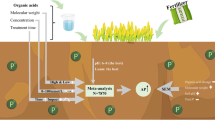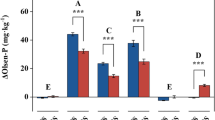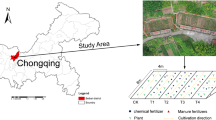Abstract
Efficient utilization of agricultural soil phosphorus (P) and mitigation of loss risks necessitate a precise evaluation of soil P storage capacity (SPSC). This study compared the effectiveness of four soil test P methods (Oxalate, Bray, Olsen, and Mehlich-1) to accurately estimate SPSC and simplify P loss risk assessment of soils located in a typical red soil in the Sunjia Watershed, Yingtan, Jiangxi Province, China. The extraction efficiencies of these methods for Fe, Al, P, and P saturation ratio (PSR) were compared, and conversion equations between SPSCOx (extracted using Oxalate) and soil test P (Bray, Olsen, and Mehlich-1) were derived through fitting analysis. The results underscored Oxalate as the optimal extractant for gauging P loss risk in red soils. Structural equation modeling (SEM) unveiled the substantial impact of amorphous iron-aluminum oxides (Feo, Alo) on SPSC, with Feo exerting a more pronounced influence than Alo. Among soil physicochemical properties, total carbon emerged as the most influential, and a strong interaction was noted between the physicochemical properties and Feo and Alo. The study delineated three crucial P concentration ranges for practical P management in red soils. When Bray-P < 48.2 mg kg–1, the soil acted as a P sink with no P loss risk, allowing for continued P application to augment crop yield. Conversely, within 48.2 mg kg–1 < Bray-P ≤ 55.2 mg kg–1, the soil attained its maximum secure P capacity; further P application significantly escalated the peril of P loss. Subsequently, when Bray-P > 55.2 mg kg–1, the soil turns into a source of P release. This signifies an escalated risk of P loss, demanding the immediate implementation of environmental protective measures.








Similar content being viewed by others
REFERENCES
D. Abdala, A. Ghosh, I. Silva, R. F. Novais, and V. Venegas, “Phosphorus saturation of a tropical soil and related P leaching caused by poultry litter addition,” Agric., Ecosyst. Environ. 162, 15–23 (2012).
A. Bhatta, R. Prasad, D. Chakraborty, J. Shaw, J. Lamba, E. Brantley, and H. Torbert, “Mehlich 3 is a generic soil test extractant for environmental phosphorus risk assessment across Alabama soil regions,” Agrosyst., Geosci. Environ. 4 (3), e20187 (2021). https://doi.org/10.1002/agg2.20187
A. Breeuwsma and S. Silva, Phosphorus Fertilization and Environmental Effects in The Netherlands and the Po Region (Italy) (Winand Staring Centre for Integrated Land, Soil, and Water Research, Wageningen, 1992).
U. Buczko and R. Kuchenbuch, “Phosphorus indices as risk-assessment tools in the U.S.A. and Europe—a review,” J. Plant Nutr. Soil Sci. 170, 445–460 (2007).
M. Campos, J. Antonangelo, and L. Alleoni, “Phosphorus sorption index in humid tropical soils,” Soil Tillage Res. 156, 110–118 (2016).
M. Campos, J. Antonangelo, S. Zee, and L. Alleoni, “Degree of phosphate saturation in highly weathered tropical soils,” Agric. Water Manage. 206, 135–146 (2018).
J. Casson, D. Bennett, S. Nolan, B. Olson, and G. Ontkean, “Degree of phosphorus saturation thresholds in manure-amended soils of Alberta,” J. Environ. Qual. 35, 2212–2221 (2006).
D. Chakraborty, V. Nair, M. Chrysostome, and W. Harris, “Soil phosphorus storage capacity in manure-impacted Alaquods: implications for water table management,” Agric., Ecosyst. Environ. 142, 167–175 (2011).
M. Chrysostome, V. Nair, W. Harris, and R. D. Rhue, “Laboratory validation of soil phosphorus storage capacity predictions for use in risk assessment,” Soil Sci. Soc. Am. J. 71, 1564–1569 (2007).
B. Dari, V. Nair, J. Colee, W. Harris, and R. Mylavarapu, “Estimation of phosphorus isotherm parameters: a simple and cost-effective procedure,” Front. Environ. Sci. 3, 70 (2015).
B. Dari, V. Nair, and W. Harris, “Approaches for evaluating subsurface phosphorus loss potential from soil profiles,” Agric., Ecosyst. Environ. 245, 92–99 (2017).
B. Dari, V. Nair, A. Sharpley, P. Kleinman, D. Franklin, and W. Harris, “Consistency of the threshold phosphorus saturation ratio across a wide geographic range of acid soils,” Agrosyst., Geosci. Environ. 1, 1–8 (2018).
S. Doydora, L. Gatiboni, K. Grieger, D. Hesterberg, J. L. Jones, E. McLamore, R. Peters, R. Sozzani, L. V. Broeck, and O. Duckworth, “Accessing legacy phosphorus in soils,” Soil Syst. 4, 74 (2020).
P. Fischer, P. Fischer, R. Pöthig, and M. Venohr, “The degree of phosphorus saturation of agricultural soils in Germany: current and future risk of diffuse P loss and implications for soil P management in Europe,” Sci. Total Environ. 599–600, 1130–1139 (2017).
G. Heckrath, P. Brookes, P. Poulton, and K. Goulding, “Phosphorus leaching from soils containing different phosphorus concentrations in the Broadbalk experiment,” J. Environ. Qual. 24, 904–910 (1995).
P. Hooda, A. Rendell, A. Edwards, P. Withers, M. Aitken, and V. Truesdale, “Relating soil phosphorus indices to potential phosphorus release to water,” J. Environ. Qual. 29, 1166–1171 (2000).
L. Hua, J. Liu, L. Zhai, B. Xi, F. Zhang, H. Wang, H. Liu, A. Chen, and B. Fu, “Risks of phosphorus runoff losses from five Chinese paddy soils under conventional management practices,” Agric., Ecosyst. Environ. 245, 112–123 (2017).
J. Huang, L. Zhou, S. Liu, T. Han, N. G. Hayatu, D. Li, S. Zhang, B. Wang, and H. Zhang, “Vertical distribution of phosphorus fractions and the environmental critical phosphorus level in acidic red soil under long-term fertilizer and lime application in southern China,” J. Plant Nutr. Soil Sci. 184, 585–595 (2021).
R. Indiati and P. Sequi, “Phosphorus intensity-quantity relationships in soils highly contrasting in phosphorus adsorption properties,” Commun. Soil Sci. Plant Anal. 35, 131–143 (2004).
G. L. Mumbach, D. A. Oliveira, M. I. Warmling, and L. C. Gatiboni, “Quantificação de fósforo por Mehlich 1, Mehlich 3 e Resina Trocadora de Ânions em solos com diferentes teores de argila,” Rev. Ceres 65, 546–554 (2018).
R. Maguire and J. Sims, “Soil testing to predict phosphorus leaching,” J. Environ. Qual. 31, 1601–1609 (2002). https://doi.org/10.2134/jeq2002.1601
V. Nair, “Soil phosphorus saturation ratio for risk assessment in land use systems,” Front. Environ. Sci. 2, 6 (2014). https://doi.org/10.3389/fenvs.2014.00006
V. Nair, M. Clark, and K. Reddy, “Evaluation of legacy phosphorus storage and release from wetland soils,” J. Environ. Qual. 44, 1956–1964 (2015).
V. Nair and W. Harris, “Soil phosphorus storage capacity for environmental risk assessment,” Adv. Agric. 2014, 723064 (2014).
V. Nair and W. Harris, “A capacity factor as an alternative to soil test phosphorus in phosphorus risk assessment,” N. Z. J. Agric. Res. 47, 491–497 (2004).
V. Nair, W. Harris, and D. Chakraborty, An Indicator for Risk of Phosphorus Loss from Sandy Soils 3 (2010). http://edis.ifas.ufl.edu/ss539
V. Nair, K. Portier, D. Graetz, and M. Walker, “An environmental threshold for degree of phosphorus saturation in sandy soils,” J. Environ. Qual. 33, 7 (2004).
V. Nair and K. Reddy, “Phosphorus sorption and desorption in wetland soils,” in Methods in Biogeochemistry of Wetlands (2015). https://doi.org/10.2136/sssabookser10.c34
V. Nair, L. Sollenberger, W. Harris, A. Sharpley, A. M. Freitas, J. Dubeux, and A. N. Rodriguez, “Mining of soil legacy phosphorus without jeopardizing crop yield,” Agrosyst., Geosci. Environ. 3 (1), e20056 (2020). https://doi.org/10.1002/agg2.20056
A. Roger, S. Sinaj, Z. Libohova, and E. Frossard, “Regional investigation of soil phosphorus saturation degree, a study case in Switzerland,” Front. Environ. Sci. 2, 6 (2014). https://doi.org/10.3389/fenvs.2014.00006
O. Schoumans and W. Chardon, “Phosphate saturation degree and accumulation of phosphate in various soil types in The Netherlands,” Geoderma 237, 325–335 (2015).
J. Sims, R. Maguire, A. Leytem, K. L. Gartley, and M. Pautler, “Evaluation of Mehlich 3 as an agri-environmental soil phosphorus test for the mid-Atlantic United States of America,” Soil Sci. Soc. Am. J. 66, 2016–2032 (2002).
K. Steinfurth, J. Hirte, C. Morel, and U. Buczko, “Conversion equations between Olsen-P and other methods used to assess plant available soil phosphorus in Europe – a review,” Geoderma 401, 115339 (2021).
P. Vadas, P. Kleinman, A. Sharpley, and B. L. Turner, “Relating soil phosphorus to dissolved phosphorus in runoff: a single extraction coefficient for water quality modeling,” J. Environ. Qual. 34, 572–580 (2005).
Y. Wang, J. Tang, H. Zhang, J. Schroder, and Y. He, “Phosphorus availability and sorption as affected by long-term fertilization,” Agron. J. 106, 1583–1592 (2014).
R. Xu, A. Zhao, Q. Li, X. Kong, and G. Ji, “Acidity regime of the Red Soils in a subtropical region of southern China under field conditions,” Geoderma 115, 75–84 (2003).
Z. Yan, S. Chen, B. Dari, D. Sihi, and Q. Chen, “Phosphorus transformation response to soil properties changes induced by manure application in a calcareous soil,” Geoderma 322, 163–171 (2018).
G. S. Yang, R. Ma, L. Zhang, J. H. Jiang, S. C. Yao, M. Zhang, and H. A. Zeng, “Lake status, major problems and protection strategy in China,” J. Lake Sci. 22 (6), 799–810 (2010).
Funding
This work was supported by the National Natural Science Foundation of China, project no. 42077087.
Author information
Authors and Affiliations
Corresponding author
Ethics declarations
CONFLICT OF INTEREST
The authors of this work declare that they have no conflicts of interest.
ETHICS APPROVAL AND CONSENT TO PARTICIPATE
This work does not contain any studies involving human and animal subjects.
Additional information
Publisher’s Note.
Pleiades Publishing remains neutral with regard to jurisdictional claims in published maps and institutional affiliations.
Rights and permissions
About this article
Cite this article
Li, H., Zhang, J. & Wang, Y. Comparative Analysis of Four Methods for Accurate Estimation of Soil Phosphorus Storage Capacity: a Case Study in a Typical Red Soil. Eurasian Soil Sc. (2024). https://doi.org/10.1134/S1064229323603402
Received:
Revised:
Accepted:
Published:
DOI: https://doi.org/10.1134/S1064229323603402




